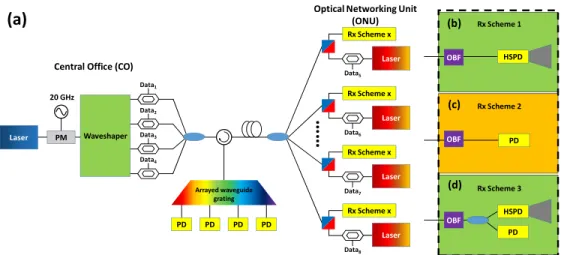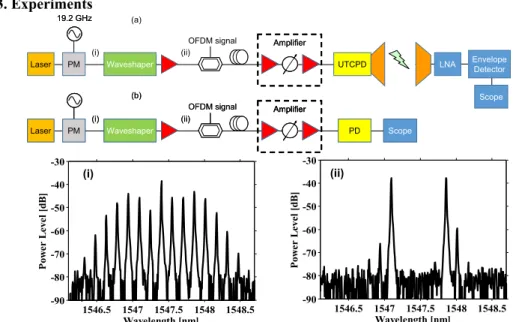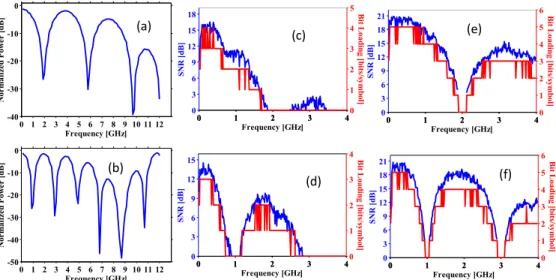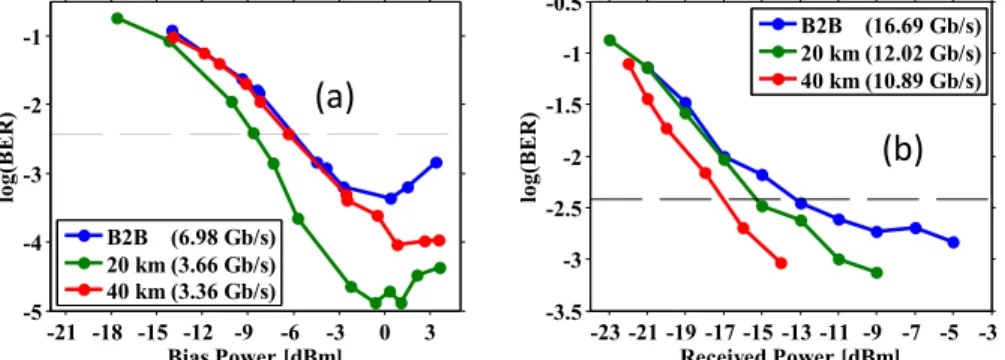A scalable and continuous-upgradable optical
wireless and wired convergent access network
J. Y. Sung,1 K. T. Cheng,2 C. W. Chow,1,* C. H. Yeh,3,4 and C.-L. Pan2
1Department of Photonics and Institute of Electro-Optical Engineering, National Chiao Tung University, Hsinchu 30010, Taiwan
2Department of Physics and Institute of Photonics Technologies, National Tsing-Hua University, Hsinchu, Taiwan 3Information and Communications Research Laboratories, Industrial Technology Research Institute, Hsinchu 31040,
Taiwan
4Graduate Institute of Applied Science and Engineering, Fu Jen Catholic University, New Taipei 24205, Taiwan
*cwchow@faculty.nctu.edu.tw
Abstract: In this work, a scalable and continuous upgradable convergent optical access network is proposed. By using a multi-wavelength coherent comb source and a programmable waveshaper at the central office (CO), optical millimeter-wave (mm-wave) signals of different frequencies (from baseband to > 100 GHz) can be generated. Hence, it provides a scalable and continuous upgradable solution for end-user who needs 60 GHz wireless services now and > 100 GHz wireless services in the future. During the upgrade, user only needs to upgrade their optical networking unit (ONU). A programmable waveshaper is used to select the suitable optical tones with wavelength separation equals to the desired mm-wave frequency; while the CO remains intact. The centralized characteristics of the proposed system can easily add any new service and end-user. The centralized control of the wavelength makes the system more stable. Wired data rate of 17.45 Gb/s and w-band wireless data rate up to 3.36 Gb/s were demonstrated after transmission over 40 km of single-mode fiber (SMF).
©2014 Optical Society of America
OCIS codes: (060.2330) Fiber optics communications; (060.4510) Optical communications; (060.4080) Modulation.
References and links
1. Z. Xu, Y. J. Wen, W.-D. Zhong, M. Attygalle, X. F. Cheng, Y. Wang, and C. Lu, “Carrier-reuse WDM-PON using a shared delay interferometer for separating carriers and subcarriers,” IEEE Photon. Technol. Lett. 19(11), 837–839 (2007).
2. G. K. Chang, A. Chowdhury, Z. Jia, H. C. Chien, M. F. Huang, J. Yu, and G. Ellinas, “Key technologies of WDM-PON for future converged optical broadband access networks,” J. Opt. Commun. Netw. 1(4), C35 (2009). 3. C. W. Chow and Y. H. Lin, “Convergent optical wired and wireless long-reach access network using high
spectral-efficient modulation,” Opt. Express 20(8), 9243–9248 (2012).
4. C. H. Yeh and C. W. Chow, “Heterogeneous radio-over-fiber passive access network architecture to mitigate Rayleigh backscattering interferometric beat noise,” Opt. Express 19(7), 5735–5740 (2011).
5. L. Xu, C. W. Chow, and H. K. Tsang, “Long reach, multicast, high split ratio wired and wireless WDM-PON using SOA for remote upconversion,” IEEE Trans. Microwave Theory Tech. 58, 3136–3143 (2010).
6. Y. Tian and Y. Su, “A WDM-PON system providing quadruple play service with converged optical and wireless access,” in Proc. ECOC (2008), Paper P.6.07.
7. H.-H. Lu, H.-C. Peng, W.-S. Tsai, C.-C. Lin, S.-J. Tzeng, and Y.-Z. Lin, “Bidirectional hybrid CATV/radio-over-fiber WDM transport system,” Opt. Lett. 35(3), 279–281 (2010).
8. C. W. Chow, F. M. Kuo, J. W. Shi, C. H. Yeh, Y. F. Wu, C. H. Wang, Y. T. Li, and C. L. Pan, “100 GHz ultra-wideband (UWB) fiber-to-the-antenna (FTTA) system for in-building and in-home networks,” Opt. Express 18(2), 473–478 (2010).
9. C. W. Chow, C. H. Yeh, S. M. Lo, C. Li, and H. K. Tsang, “Long-reach radio-over-fiber signal distribution using single-sideband signal generated by a silicon-modulator,” Opt. Express 19(12), 11312–11317 (2011).
10. J. Y. Sung, C. W. Chow, C. H. Yeh, and Y. C. Wang, “Service integrated access network using highly spectral-efficient MASK-MQAM-OFDM coding,” Opt. Express 21(5), 6555–6560 (2013).
11. A. Ng’oma, D. Fortusini, D. Parekh, W. Yang, M. Sauer, S. Benjamin, W. Hofmann, M. C. Amann, and C. J. Chang-Hasnain, “Performance of a multi-Gb/s 60 GHz radio over fiber system employing a directly modulated optically injection-locked VCSEL (Invited),” J. Lightwave Technol. 28(16), 2436–2444 (2010).
12. C. W. Chow, L. Xu, C. H. Yeh, C. H. Wang, F. Y. Shih, H. K. Tsang, C. L. Pan, and S. Chi, “Mitigation of signal distortions using reference signal distribution with colorless remote antenna units for radio-over-fiber applications,” J. Lightwave Technol. 27(21), 4773–4780 (2009).
13. X. Li, Z. Dong, J. Yu, J. Zhang, L. Tao, Y. Shao, and N. Chi, “Performance improvement by pre-equalization in w-band (75–110GHz) RoF system,” in Proc. OFC (2013), Paper OW1D.3.
14. C. W. Chow, C. H. Yeh, C. H. Wang, C. L. Wu, S. Chi, and C. Lin, “Studies of OFDM signal for broadband optical access networks,” IEEE J. Sel. Areas Commun. 28(6), 800–807 (2010).
15. C. W. Chow, C. H. Yeh, C. H. Wang, F. Y. Shih, C. L. Pan, and S. Chi, “WDM extended reach passive optical networks using OFDM-QAM,” Opt. Express 16(16), 12096–12101 (2008).
1. Introduction
Passive optical network (PON) has provided high bandwidth and cost-effective communication worldwide. To meet the ever increasing bandwidth demand, PON may need to upgrade continuously. Seamless migration without affecting the existing optical distribution network (ODN) is essential. In addition, in order to provide a more convenient and cost-effective application, service integration is particularly important. Multiple-play service systems were proposed for the convergence of Internet data, voice, video, and mobile services [1–5]. This can be implemented by using wavelength-division multiplexing (WDM) [1, 6], radio-over-fiber (RoF) technologies [7–9]; and spectral-efficient coding techniques [10]. In these multiple-play systems, providing wireless services are important for mobile applications. Increasing bandwidth requirement has mandated the use of higher frequency band. To date, 60 GHz [2, 11] and 80 GHz [12] wireless applications have been reported. Exploring ever higher frequency band, such as 100 GHz, is currently being considered [8, 13].
In this work, a scalable and continuously upgradable service-integrated convergent access network is proposed. By using a multi-wavelength coherent comb source and a programmable waveshaper at the central office (CO), optical millimeter-wave (mm-wave) signals of different frequencies (from baseband to > 100 GHz) can be generated. Hence, this scheme provides a scalable and continuously upgradable solution for any end-user who needs 60 GHz wireless services now and > 100 GHz wireless services in the future. During the upgrade, user only needs to upgrade their optical networking unit (ONU). The programmable waveshaper selects the suitable optical tones with wavelength separation corresponding to the desired mm-wave frequency; while the CO remains intact. Besides, all the services integrated in this network are centralized; hence the ONUs can be simple and low cost.
2. Proposed architecture
Figure 1(a) shows the proposed convergent access network. An optical continuous-wave (CW) tunable laser is launched into a phase-modulator (PM), which is driven by a 20 GHz electrical sinusoidal signal. An optical comb source with 20 GHz free spectral range (FSR) is generated at the output of PM. The multi-wavelength optical comb source is then launched into a programmable waveshaper. Four output ports are shown in the figure. These are then connected to optical modulators, which are driven by different data to produce four channels. Orthogonal frequency-division multiplexing (OFDM) signals are used to guarantee high data rate transmission while low bandwidth optical components optimized for GPON and XG-PON can still be used [14]. It is also robust against fiber chromatic dispersion in baseband transmission [15]. The modulated signals are combined and launched into a standard single mode fiber (SMF) for transmission. At the remote node (RN), a power splitter distributes the optical power to different end-user ONUs, in which a red-blue band filter separates the downstream and upstream signals. Each downstream wavelength is selected by an optical band-pass filter (OBF). After the OBF, the optical signal is converted into electrical signal by a photo-diode (PD). Laser source at each ONU is modulated to produce the upstream signal. It is received by PDs at the central office.
(a)
……
Rx Scheme x Laser Data7 Rx Scheme x Laser Data8 Rx Scheme x Laser Data6 Rx Scheme x Laser Data5 Rx Scheme 1 Rx Scheme 2 Rx Scheme 3 PD HSPD OBF PD OBF HSPD OBF (b) (c) (d) Laser PM Data3 Data4 Data1 Data2 Waveshaper PD PD PD PD Arrayed waveguide grating 20 GHzCentral Office (CO)
Optical Networking Unit (ONU)
Fig. 1. The proposed convergent access network. PM: phase modulator; PD: photo-diode; HSPD: high speed photo-diode; Rx: receiver; OBF: optical bandpass filter.
0 40 80 120 160 200 240 280 320 360 0 1 Normalized Frequency [GHz] N orm alized Po w er [a .u .] 0 60 120 180 240 300 360 0 1 Normalized Frequency [GHz] N orm alized Po w er [a .u .] 0 90 180 270 360 0 1 Normalized Frequency [GHz] N orm alized Po w er [a .u .] 0 100 200 300 0 1 Normalized Frequency [GHz] N orm alized Po w er [a .u .] Baseband 60 GHz 90 GHz 100 GHz (a) (b) (c) (d)
Fig. 2. Schematic spectra after the waveshaper showing the strategy of providing different mm-wave frequencies applications, and the continuous-upgrade scheme. Different colors denotes different channels. Dash curve: the frequency responses of the OBFs of different channels at the ONUs.
At the ONU, different receiver (Rx) schemes can be implemented for different applications. For wireless and high-frequency applications, a high speed photo-diode (HSPD) [8] can be used to receive the optical beating signal for generating high-frequency wireless data as shown in Fig. 1(b). An antenna is cascaded after the HSPD to transmit the signal wirelessly. For services of typical bandwidth, a lower speed PD is used to receive the baseband OFDM signal as shown in Fig. 1(c). It is also worth to mention that different OFDM subcarriers can be further shared by different users requiring limited bandwidth by using orthogonal frequency division multiple access (OFDMA). For service diversity end-user, the above Rx can be combined using an optical coupler, as shown in Fig. 1(d).
The strategy of providing different mm-wave frequencies applications, as well as the continuous-upgrade scheme is shown in Fig. 2. Different mm-wave is generated by the optical beating between two tones selected by the programmable waveshaper. The resulting mm-wave has its center frequency depending on the spacing between the two optical tones
after the OBF. For baseband applications, only a single wavelength passes through the OBF as shown in Fig. 2(a). For 60 GHz service and 100 GHz services, three wavelengths are typically passing through each OBF, as shown in Figs. 2(b)–2(d). The optical beating among the three wavelengths may generate unwanted beating tones from 10 to 20 GHz, and these low frequencies signals can be removed by high-pass transfer function of the antennas. 3. Experiments 1546.5 1547 1547.5 1548 1548.5 -90 -80 -70 -60 -50 -40 -30 Wavelength [nm] Po w er L ev el [ dB ] (i) 1546.5 1547 1547.5 1548 1548.5 -90 -80 -70 -60 -50 -40 -30 Wavelength [nm] Po w er L ev el [ dB ] (ii)
Laser PM Waveshaper UTCPD LNA Envelope Detector
Amplifier Amplifier Scope 19.2 GHz 19.2 GHz OFDM signal (a) (i) (ii) Laser PM PD Amplifier Scope OFDM signal (b) (i) (ii) Waveshaper Laser PM PD Amplifier Amplifier Scope OFDM signal (b) (i) (ii) Waveshaper
Fig. 3. Proof-of-concept experimental setup for (a) w-band wireless communication and (b) baseband wired communication. Inset: optical spectra of (i) the generated comb source by PM, and (ii) the filtered optical two tones after the programmable waveshaper.
The proof-of-concept experimental setup is shown in Fig. 3(a). A CW laser was launched into a PM, which was driven by a 19.2 GHz clock. It was selected to produce a beating signal matching our HSPD (i.e. 19.2 x 5 = 96 GHz). The spectrum of the comb source proposed is shown in inset (i) of Fig. 3. Two tones of the comb source were selected from the comb source using the programmable waveshaper, and are shown in inset (ii) of Fig. 3. The programmable waveshaper (Finisar, 4000S) is based on liquid crystal on silicon (LCoS) technology. It works in C-band, with frequency and bandwidth setting accuracies of ± 2.5 GHz and ± 5 GHz respectively. The insertion loss, polarization dependent loss (PDL) and return loss are 4.5 dB, 0.2 dB and > 25 dB respectively. After the waveshaper, the two optical tones were amplified and modulated via a Mach-Zehnder modulator (MZM), which was driven by OFDM signal, which was generated off-line with 512 fast Fourier transform (FFT) sizes. The OFDM signal was launched by an arbitrary waveform generator (AWG) with 8 Gsample/s sampling rate. The available spectrum could be efficiently used by bit-loading technique to increase the data rate. After the MZM, the optical OFDM signal was launched into the SMF (20 km and 40 km) without dispersion compensation. Erbium-doped fiber amplifiers (EDFAs) were used to compensate the power loss during transmission and to provide enough optical power for the HSPD. In our experiment, the HSPD is a uni-traveling carrier photodiode (UTCPD) [8] having modulation response of 2 GHz, and producing electrical signal at ~96 GHz. A horn antenna was connected to the UTCPD for wireless signal transmission. Then the wireless w-band signal was received by another horn antenna and amplified by a low noise amplifier (LNA). After an envelope detector, the detected electrical signal was sent to a high-speed oscilloscope for display. Besides the analysis of w-band wireless transmission, wired optical fiber transmission without using the UTCPD and horn antennas was also studied and analyzed. In this case, the optical OFDM signal was received by a 10 GHz PD, as shown in Fig. 3(b).
4. Results and discussion
As the wireless signal is produced by the optical beating between two optical tones carrying information, it will suffer from radio-frequency (RF) power fading effect during fiber transmission. Figures 4(a) and 4(b) show the simulated RF power fading at different frequencies after 20 km and 40 km of SMF transmission, respectively. VPI Transmission Maker V7.5 was used for the simulation. The simulation was based on the setup shown in Fig. 3(b), in which two optical tones after the waveshaper were launched into a MZM, which was electrically driven by sinusoidal signals sweeping from DC to 12 GHz. Hence, at the output of the MZM, 6 optical tones (2 carriers, each has upper and lower sidebands) were generated. When these signals were propagating in an optical fiber, chromatic dispersion caused differential delay to be progressively added to the 4 sidebands and 2 carriers. Hence repetitive, length dependent power fluctuation (power fading) was observed at the received signal. Power nulls appear every 4-GHz after 20 km of SMF transmission; and power nulls appear every 2-GHz after 40 km SMF transmission. The power fading phenomenon can also be seen in the experimental results. Figures 4(c) and 4(d) show the measured signal-to-noise ratio (SNR) performance over different frequencies of the proposed system with w-band wireless transmission after 20 km and 40 km SMF transmission, respectively. We can observe that a SNR null appears at around 2 GHz after 20 km of transmission; and the SNR nulls appear at around 1 GHz and 3 GHz after 40 km of transmission. The experimental results are in good agreement with the simulation results. Figures 4(e) and 4(f) show the measured SNR performance over different frequencies of the proposed system without wireless transmission after 20 km and 40 km of SMF transmission, respectively. The experimental results also match those of the simulation results. The narrower frequency responses of Figs. 4(c) and 4(d) are due to the limited bandwidth of the UTCPD. To achieve higher data rate, bit-loading technique was used for the OFDM signal. The data formats used for the OFDM subcarriers were determined by the SNR. The allocation of the data format of each OFDM subcarrier was also shown in Figs. 4(c)–4(f).
0 1 2 3 4 0 3 6 9 12 15 18 SNR [ dB ] Frequency [GHz] 0 1 2 3 40 1 2 3 4 5 Bi t Lo ad in g [b its /sy m bo l] (c) 0 1 2 3 4 0 3 6 9 12 15 SNR [ dB ] Frequency [GHz] 0 1 2 3 40 1 2 3 4 Bi t Lo ad in g [b its /sy m bo l] (d) 0 1 2 3 4 0 3 6 9 12 15 18 21 SNR [ dB ] Frequency [GHz] 0 1 2 3 40 1 2 3 4 5 6 Bi t Lo ad in g [b its /sy m bo l] (e) 0 1 2 3 4 0 3 6 9 12 15 18 21 SNR [ dB ] Frequency [GHz] 0 1 2 3 40 1 2 3 4 5 6 Bi t Lo ad in g [b its /sy m bo l] (f) 0 1 2 3 4 5 6 7 8 9 10 11 12 -40 -30 -20 -10 0 Frequency [GHz] N orm al iz ed P ow er [ dB ] (a) 0 1 2 3 4 5 6 7 8 9 10 11 12 -50 -40 -30 -20 -10 0 Frequency [GHz] N orm al iz ed P ow er [ dB ] (b)
Fig. 4. Simulated power fading after (a) 20 km and (b) 40 km SMF. Measured SNR and bit-loading of the system with w-band wireless transmission after (c) 20 km and (d) 40 km SMF transmission; and without wireless transmission after (e) 20 km and (f) 40 km SMF transmission.
Next, the bit error rate (BER) performance of the proposed system with w-band wireless (beating of 2 optical tones) transmission was evaluated. Figure 5(a) was the BER measurement results of the w-band wireless transmission experiment. The maximum data rate achieved was 6.98 Gb/s, which is limited by the HSPD. With fiber transmission, the RF power fading in the transmission fiber reduces the maximum data rate. Approximately 3 Gb/s
was achieved after 40 km fiber transmission. Figure 5(b) was the BER performance of the signal without the wireless transmission. It can be used as the wired applications as well. The signal was received by a 10 GHz PD, as shown in Fig. 3(a). With bit loading scheme and higher bandwidth PD, within 40 km transmission, over 10 Gb/s/wavelength was achieved.
Finally, the BER performance of the baseband OFDM signal with single wavelength (1 optical tone) was performed. There was negligible power penalty within 40 km transmission as shown in Fig. 6(a). Figure 6(b) shows the SNR of each subcarrier of the baseband OFDM signal with the bit-loading scheme. It was seen that the RF power fading phenomenon can be neglected in this case. For this baseband signal, 17.45 Gb/s data rate was achieved within 4 GHz bandwidth for single wavelength.
-23 -21 -19 -17 -15 -13 -11 -9 -7 -5 -3 -3.5 -3 -2.5 -2 -1.5 -1 -0.5 Received Power [dBm] lo g(BER ) B2B (16.69 Gb/s) 20 km (12.02 Gb/s) 40 km (10.89 Gb/s) -21 -18 -15 -12 -9 -6 -3 0 3 -5 -4 -3 -2 -1 Bias Power [dBm] lo g(BER ) B2B (6.98 Gb/s) 20 km (3.66 Gb/s) 40 km (3.36 Gb/s)
(a)
(b)
Fig. 5. The BER performance of the w-band wireless signal with different SMF transmission distances. (b) The signal performance at maximum transmission data rate in the wired
communication with different fiber transmission distances. Dash curve: BER = 3.8 x 10−3.
-24 -21 -18 -15 -12 -9 -6 -3 -2.5 -2 -1.5 -1 -0.5 Received Power [dBm] lo g(BER ) B2B 20 km 40 km
(a)
0 1 2 3 4 0 3 6 9 12 15 18 21 24 SNR [ dB ] Frequency [GHz] 0 1 2 3 40 1 2 3 4 5 6 7 Bi t Loa di ng [b its /sy mb ol ](b)
Fig. 6. (a) Measured BER using a single wavelength baseband signal with different transmission distances. (b) The corresponding SNR with bit-loading scheme.
4. Conclusion
A scalable and continuous-upgradable optical wireless and wired convergent access network was proposed. By using a multi-wavelength coherent comb source and a programmable waveshaper at the CO, different frequencies (from baseband to > 100 GHz) optical mm-wave signals can be generated. During the upgrade to higher frequencies, user only needs to upgrade their ONU and the programmable waveshaper selects the suitable optical tones with wavelength separation equals to the desired mm-wave frequency; while the CO remains intact. The use of OFDM made the proposed system highly spectral-efficient and can be controlled dynamically. 17.45 Gb/s wired and 3.36 Gb/s w-band wireless data were demonstrated in 40 km SMF transmission.
Acknowledgments
This work was financially supported by the National Science Council, Taiwan, R.O.C., under Contract NSC-101-2628-E-009-007-MY3, NSC-100-2221-E-009-088-MY3.



